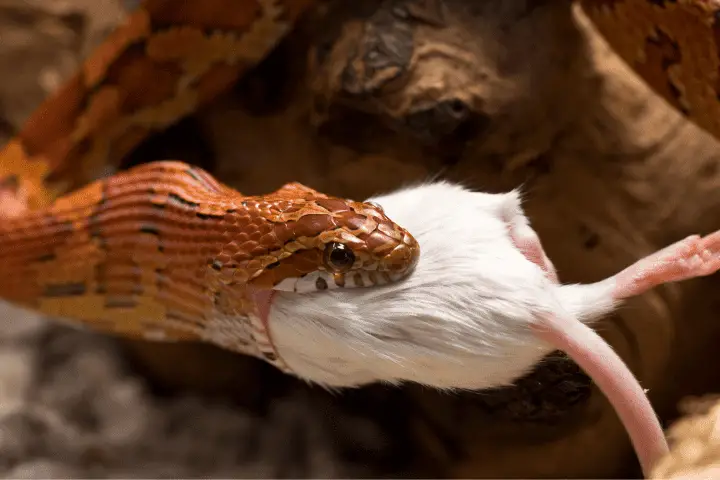Can Snakes Choke
Snakes are captivating critters with one-of-a-kind adaptations.
Can they choke their victims? This question has a curious answer.
Choking, as humans know it, isn’t something that snakes can do.
They don’t have a diaphragm or larynx like mammals. They have another way to capture and consume their prey.
Constriction is the process of subduing their victims through powerful muscles.
They wrap around the prey, limit air flow for smaller animals or break bones of bigger ones.
Constrictor snakes have unique features that help them hunt.
Their jaws stretch wide to eat big meals. Some even have heat sensing organs called pit organs
to find warm-blooded animals in dark.
To make sure snakes have a happy mealtime, owners need to provide the right size prey.
Too large of prey can be dangerous if consumed wrong. Also, defrost frozen prey before feeding to aid digestion.
Lastly, offer hiding spots in the enclosure.
This mimics natural shelters after catching prey. It makes the environment stress-free and promotes wellness.
Explanation of snake physiology
Snakes have an amazing physiology that allows them to do incredible things. Can they really choke their prey? The answer is both amazing and surprising.
Snakes have an unusual anatomy which lets them swallow large prey whole. Unlike us, their lower jaw can unhinge, letting them open wider than their body diameter.
This adaptation means they can eat bigger than their head!
When hunting, snakes use their strength and agility to subdue their prey. Contrary to popular belief, they don’t choke their victims like in a wrestling match.
They use constriction to keep them from escaping.
Using their muscles, some snakes will wrap tightly around their target and apply pressure. This stops blood from flowing and eventually paralyzes the prey.
The amount of constriction varies depending on the snake species and size of the meal.
For example, an African rock python was seen capturing an adult impala twice its length. It wound its muscular body around the antelope, using constriction as its main technique.
Over time, the python’s grip stopped blood circulation, leaving the impala helpless.
This shows just how amazing snakes are in terms of hunting and physiology.
Discussion on the possibility of snakes choking
Do snakes choke? The answer is both yes and no. Snakes have a special, “double-jointed” jaw that enables them to stretch their mouths to consume prey larger than their head.
This prevents obstruction and reduces the risk of choking.
But, when a snake encounters prey that’s too big for them, or struggles to align it, they may experience difficulty breathing.
This can cause distress and the risk of choking.
In these cases, it’s best not to intervene. Trying to remove or manipulate their prey could make things worse.
We should trust in the resilience and adaptability of snakes and give them the space to maneuver during feeding episodes.
Although snakes can choke, they possess incredible adaptations that help them survive.
By allowing them the freedom to use their natural abilities, we contribute to their well-being and ensure they stay a vital part of ecosystems worldwide.
Examples of cases where snakes may appear to be choking
Do snakes choke like humans? Shockingly, no! Snakes don’t have diaphragms or vocal cords.
But, there are cases where they look like they are choking.
- Regurgitation: Too-large prey can get stuck in the throat and look like they are choking.
- Foreign body ingestion: Snakes sometimes eat things not meant for them, like rocks. These can block their airways and seem like choking.
- Respiratory infections: Illnesses can lead to swelling in airways and look like choking.
- Injury or trauma: Injuries can also cause breathing problems that appear like choking.
Plus, some snake species may act like they are choking as a defensive display. But it’s just for intimidation.
Surprisingly, snakes don’t have a hyoid bone like mammals and birds.
So, they don’t physically choke. But, you may see them spit up dinner!
Explanation of the snakes’ unique ability to regurgitate
Snakes possess an amazing power – regurgitation. It lets them throw up undigested food from their bellies. This incredible process helps them to stay alive and enables them to digest their meals properly.
When they consume a large meal, their muscles contract to push the food down their throats and into their stomachs. But sometimes the meal can be too big or hard to digest.
In these cases, snakes can regurgitate the prey.
Regurgitation is when the snake reverses the movement of its digestive system, forcing the food back up through its esophagus and out of its mouth.
This allows them to expel any indigestible parts or toxins they may have swallowed.
Surprisingly, snakes can do this without hurting themselves.
Their digestive systems are made for this, with flexible bones and stretchy tissues that let them swallow and regurgitate.
But it’s important to note that regurgitation isn’t a regular thing for snakes. It usually happens when they are under stress, like when they feel threatened or have eaten something not good for them.
Throughout time, snakes have regurgitated surprising items. Like in 1888, when a Scientific American article told of a snake that had swallowed a whole crocodile, but was unable to digest it.
The snake eventually managed to throw up most of its meal after several days of hard effort.

